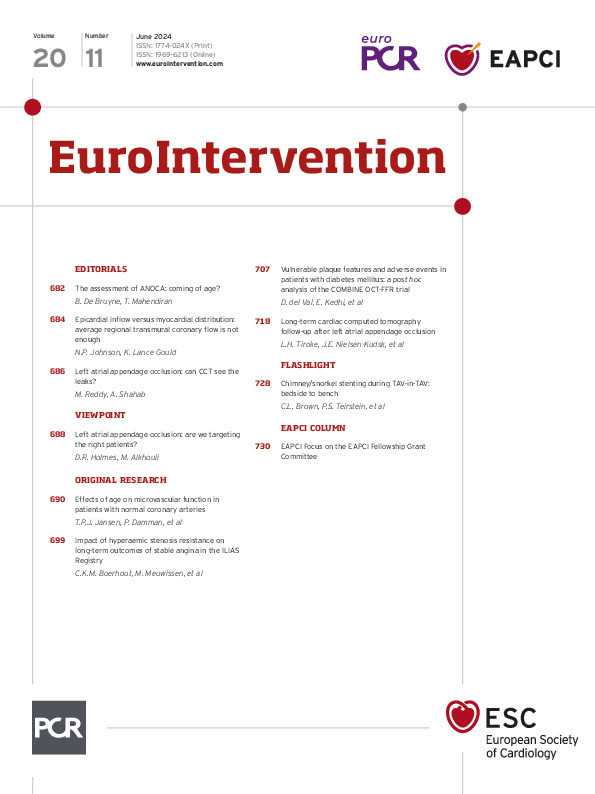Can one think of a single physiological function that does not deteriorate with age? It would have been surprising to see that the function of the coronary microcirculation behaved any differently, and this impression is supported by recent work1.
Accordingly, the results published in this issue of EuroIntervention by Jansen et al2 come as no surprise. However, to tackle the question of how microvascular function changes in older patients, the authors used, for the first time, continuous thermodilution-derived absolute flow and resistance measurements. Microvascular function was evaluated in a cohort of 305 patients with angina with no obstructive coronary artery disease (ANOCA). The mean age of the cohort was 59±9 years, and the vast majority of patients were female (83%). Of note, significant epicardial disease was totally excluded, both in terms of significant focal disease (any diameter stenosis >30%) and haemodynamically significant disease (fractional flow reserve [FFR] ≤0.80). In order to evaluate the impact of age on measures of microvascular function, linear regression was used with age as a continuous variable, whilst the cohort was also analysed in 3 age groups (≤52 years old, 53-64 years old, ≥65 years old).
Whilst there were no differences between groups in terms of resting absolute flow (Qrest) or microvascular resistance (Rμ,rest), the authors noted a small decrease in hyperaemic flow (Qmax) with increasing age and a corresponding small, but significant, increase in hyperaemic microvascular resistance (Rμ,hyper). This translated into a significant age-associated decrease in microvascular resistance reserve (MRR) from 3.2±1.2 in patients ≤52 years old to 2.9±0.9 in those ≥65 years old. Furthermore, using an MRR cutoff of <2.7 to define coronary microvascular dysfunction (CMD), the authors found that this age-associated phenomenon occurred in patients in all 3 groups, regardless of the presence or absence of CMD.
Apart from the expected association between microvascular function and age, it is worth noting that Qrest remained remarkably stable with increasing age. In fact, it was only a very modest increase in Rμ,hyper that resulted in the small, but significant, decrease in both Qmax and MRR in the elderly patients. Critically, these data demonstrate an association between age and declining microvascular function, but they do not demonstrate causation. As shown in Table 4 of the paper by Jansen et al, elderly patients had significantly more comorbidities, many of which are known to affect vascular function. As such, further work is needed in order to explore the putative pathophysiological mechanisms responsible for the link.
Yet, perhaps more valuable still, this work highlights certain methodological aspects that warrant further discussion:
1) What is the optimal modality for the assessment of microvascular function? The authors deserve praise for their approach to the microvascular assessment. Continuous thermodilution is the gold-standard intracoronary modality for assessing volumetric coronary blood flow due to its excellent accuracy, as compared with [15O]H2O positron emission tomography (PET) perfusion imaging, and its superior precision over bolus thermodilution and Doppler34. Furthermore, it permits the calculation of a range of indices that can be used to assess the microvascular compartment: Qrest, Qmax, Rμ,rest, Rμ,hyper, coronary flow reserve and MRR. Yet these indices can likely be condensed into just two that encapsulate microvascular function: Rμ,hyper and MRR.
2) Rμ,hyper and MRR provide complementary information on microvascular function and should be evaluated in conjunction. Rμ is the quintessential descriptor of microvascular function, and continuous thermodilution stands out for its capacity to quantify it in absolute terms (Wood units). Whilst bolus thermodilution provides a dimensionless surrogate of Rμ,hyper – the index of microcirculatory resistance (IMR) – only continuous thermodilution permits its quantification in absolute terms. This is relevant, as there is emerging evidence that Rμ,hyper permits the distinction between structural and functional CMD5. As such, tools that accurately quantify Rμ,hyper will play an increasingly important role in ANOCA assessment.
Yet, Rμ is not sufficient as a standalone metric, as it is influenced by subtended myocardial mass; the larger the mass, the higher the flow, and thus, the lower the resistance. MRR, on the other hand, quantifies the vasodilatory reserve of the microcirculation and is independent of subtended myocardial mass6. In addition, whereas CFR is influenced by the presence of concomitant epicardial disease, MRR corrects for epicardial resistance (i.e., FFR), making it truly specific for the microvascular compartment. However, it is worth noting that MRR, like CFR, remains sensitive to abnormally high values of Qrest that are sometimes seen during ANOCA assessments; these may not reflect the true pathology but rather patient anxiety or stress.
What remains to be ascertained is the optimal MRR and Rμ,hyper cutoff values for the diagnosis of CMD. Whilst Jansen et al utilised an MRR cutoff of 2.7, a value of 3.0 has recently been proposed7. In reality, the optimal cutoff is likely in or around this range but should ideally be defined by clinical outcomes data. This represents one of the objectives of the currently enrolling Euro-CRAFT study (ClinicalTrials.gov: NCT05805462), which will provide prognostic data on a large cohort of ANOCA patients who will undergo thorough coronary function testing, including continuous thermodilution.
To conclude, there have been considerable advances in the awareness and understanding of ANOCA in recent years. Our focus should now shift towards standardising how we assess for its underlying causes so that clinicians can make clear and consistent decisions about their patients.
Conflict of interest statement
B. De Bruyne has a consulting relationship with Boston Scientific, Abbott, CathWorks, Siemens, and Coroventis Research; receives research grants from Abbott, Coroventis Research, CathWorks, and Boston Scientific; and holds minor equities in Philips Volcano, Siemens, GE HealthCare, Edwards Lifesciences, HeartFlow, Sanofi, and Celyad. T. Mahendiran is supported by a grant from the Swiss National Science Foundation (SNSF).

